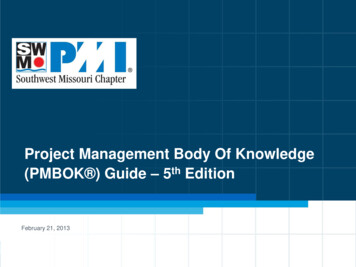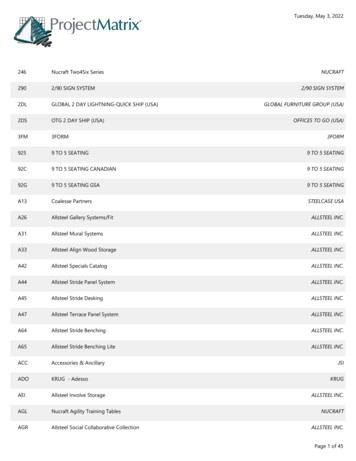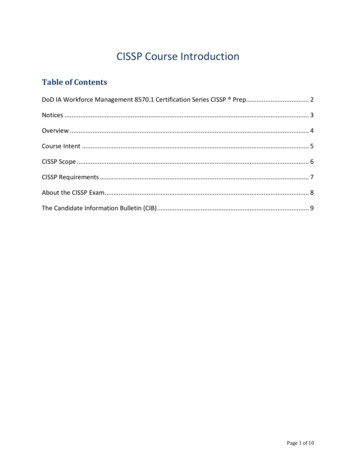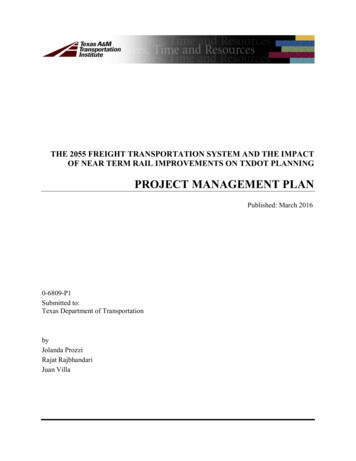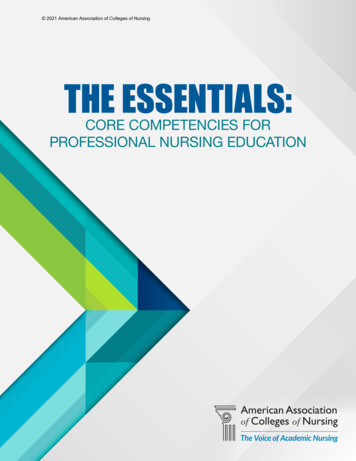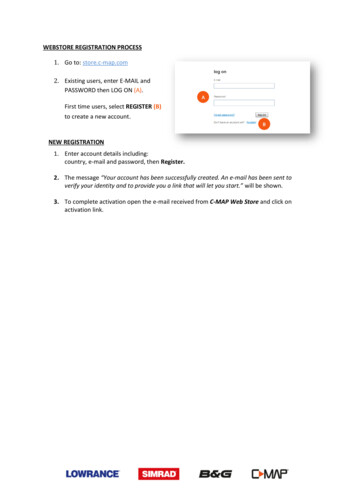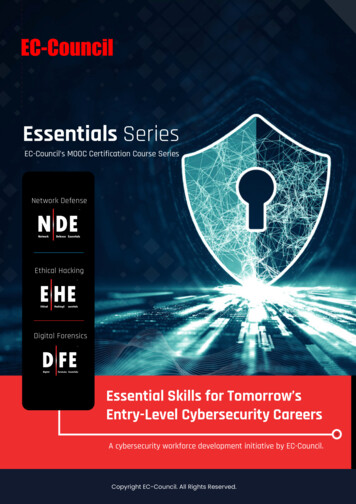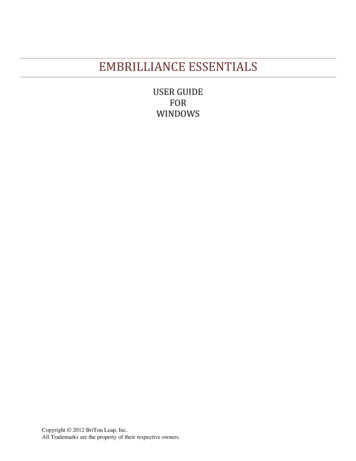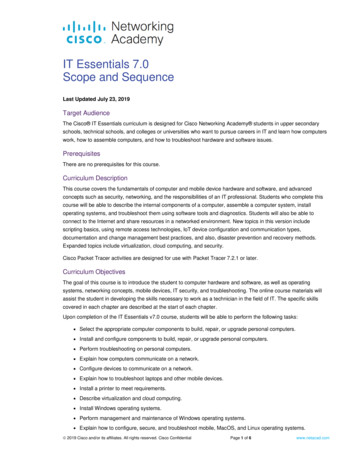
Transcription
IT Essentials 7.0Scope and SequenceLast Updated July 23, 2019Target AudienceThe Cisco IT Essentials curriculum is designed for Cisco Networking Academy students in upper secondaryschools, technical schools, and colleges or universities who want to pursue careers in IT and learn how computerswork, how to assemble computers, and how to troubleshoot hardware and software issues.PrerequisitesThere are no prerequisites for this course.Curriculum DescriptionThis course covers the fundamentals of computer and mobile device hardware and software, and advancedconcepts such as security, networking, and the responsibilities of an IT professional. Students who complete thiscourse will be able to describe the internal components of a computer, assemble a computer system, installoperating systems, and troubleshoot them using software tools and diagnostics. Students will also be able toconnect to the Internet and share resources in a networked environment. New topics in this version includescripting basics, using remote access technologies, IoT device configuration and communication types,documentation and change management best practices, and also, disaster prevention and recovery methods.Expanded topics include virtualization, cloud computing, and security.Cisco Packet Tracer activities are designed for use with Packet Tracer 7.2.1 or later.Curriculum ObjectivesThe goal of this course is to introduce the student to computer hardware and software, as well as operatingsystems, networking concepts, mobile devices, IT security, and troubleshooting. The online course materials willassist the student in developing the skills necessary to work as a technician in the field of IT. The specific skillscovered in each chapter are described at the start of each chapter.Upon completion of the IT Essentials v7.0 course, students will be able to perform the following tasks: Select the appropriate computer components to build, repair, or upgrade personal computers. Install and configure components to build, repair, or upgrade personal computers. Perform troubleshooting on personal computers. Explain how computers communicate on a network. Configure devices to communicate on a network. Explain how to troubleshoot laptops and other mobile devices. Install a printer to meet requirements. Describe virtualization and cloud computing. Install Windows operating systems. Perform management and maintenance of Windows operating systems. Explain how to configure, secure, and troubleshoot mobile, MacOS, and Linux operating systems. 2019 Cisco and/or its affiliates. All rights reserved. Cisco ConfidentialPage 1 of 6www.netacad.com
Implement basic host, data, and network security. Explain the roles and responsibilities of the IT Professional.Minimum System RequirementsFor the best learning experience, we recommend a typical class size of 12 to 15 students and a ratio of one LabPC per student. At most, two students can share one Lab PC for the hands-on labs. Some lab activities require thestudent Lab PCs to be connected to a local network.The student Lab PCs will be in various states of assembly and repair and therefore are not suitable for viewing thecurriculum.Lab PC Hardware RequirementsIn order to be able to implement the different topologies that are used in the lab exercises of the ITE curricula,Academies teaching the course will require the following equipment (at a minimum): Windows 7.0, Windows 8.0, Windows 8.1, or Windows 10 (course will focus on Windows 10) 1 PC Case with a minimum 300W power supply 1 PCI, PCIe, or AGP-compatible motherboard Intel or AMD CPU, 1 gigahertz (GHz) or faster with support for PAE, NX, and SSE2 1 CPU heat sink and cooling fan 2 gigabyte (GB) RAM (32-bit) or 4 GB RAM (64-bit) (2 X 1GB or 2 X 2GB suggested)oSome labs will require one module of RAM to be uninstalled or the simulation of a faulty modulefor troubleshooting purposes. 60 GB hard drive (minimum); 80 GB or more (recommended) The computer must support a full installation of Windows and two additional partitions of the same size 1 DVD-ROM (minimum), DVDR, or BD/BDR 1 Ethernet Card (If the motherboard does not have an Ethernet port) 1 Wireless network adapter (compatible with the wireless router) 1 PCI, PCIe (recommended), or AGP video cardoDirectX 9 graphics device with WDDM driver Cables to connect HDD/CD (Quantities vary) 1 Mouse 1 Keyboard 1 Super VGA (1024 X 768) or higher-resolution video monitorLab PC Software RequirementsIT Essentials 7.0 content focuses on Microsoft Windows 10. Microsoft offers discount programs for academicinstitutions to purchase software at a reduced cost. Please visit the Microsoft website for your country or region tolearn more. 2019 Cisco and/or its affiliates. All rights reserved. Cisco ConfidentialPage 2 of 6www.netacad.com
Lab PC Repair ToolsThe computer toolkit should include the following tools: Phillips screwdriver Flathead screwdriver Hex Socket Drivers (various sizes) (optional) Electrostatic discharge (ESD) wrist strap and cord Electrostatic discharge (ESD) mat with a ground cord Safety glasses Lint-free cloth Electronics cleaning solution (optional) Flashlight Thermal compound Multimeter Compressed air service canister (optional due to globally varying classroom health and safety laws) Power supply tester Wire cutters RJ-45 Crimpers Cable strippers Modular cable tester Network Loop back plugs (optional)Additional Required Lab EquipmentIn addition to the equipment specified above, the lab topologies of ITE require the use of the following equipmentand accessories: 1 Internet connection for Internet searches and driver downloads (this could be the instructor'sworkstation) 1 printer or integrated printer/scanner/copier for the class to share 1 wireless router with WPA2 support for the class to share Ethernet cable and RJ-45 connectors for building and testing working cables Various USB flash drives for moving files between computers in the labs Smartphones and tablets are desirable for use with the labs in the Mobile Devices chapterIT Essentials v7.0 OutlineThis course provides a comprehensive introduction to the IT industry and in-depth exposure to personalcomputers, hardware, and operating systems. Students learn how various hardware and software componentswork and best practices in maintenance, safety, and security. Through hands-on lab activities, students learn howto assemble and configure computers, install operating systems and software, and troubleshoot hardware andsoftware issues. 2019 Cisco and/or its affiliates. All rights reserved. Cisco ConfidentialPage 3 of 6www.netacad.com
Chapter OutlineTable 1.Chapter OutlineChapter /SectionChapter 1. Introduction to PersonalComputer HardwareGoals/ObjectivesSelect the appropriate computer components to build, repair, or upgrade personalcomputers.1.1 Personal ComputersExplain how personal computer components work together.1.2 PC ComponentsExplain the Features and Functions of components.1.3 Computer DisassemblyDisassemble a PC.Chapter 2. PC AssemblyInstall components to build, repair, or upgrade personal computers.2.1 Assemble the ComputerBuild a computer.Chapter 3. Advanced ComputerInstall and configure components to upgrade a computer.Hardware3.1 Boot the ComputerExplain how to verify BIOS and UEFI settings.3.2 Electrical PowerExplain electrical power.3.3 Advanced Computer FunctionalityExplain computer functionality.3.4 Computer ConfigurationSelect components to upgrade a computer to meet requirements3.5 Protecting the EnvironmentExplain the necessary procedures to protect the environmentChapter 4. Preventive Maintenance andPerform Troubleshooting on personal computers.Troubleshooting4.1 Preventive MaintenanceExplain why preventive maintenance must be performed on personal computers.4.2 Troubleshooting ProcessTroubleshoot problems with PC and Peripheral devicesChapter 5. Networking ConceptsExplain how computers communicate on a network.5.1 Network Components and TypesExplain the components and types of computer networks.5.2 Networking Protocols, Standards, andExplain networking protocols, standards and services.Services5.3 Network DevicesExplain the purpose of devices on a network.5.4 Network CablesBuild a network cable.Chapter 6. Applied NetworkingConfigure devices to communicate on a network.6.1 Device to Network ConnectionConfigure devices for wired and wireless networks.6.2 Basic Troubleshooting Process forTroubleshoot problems and solutions related to networks.NetworksChapter 7. Laptops and Other MobileExplain how to troubleshoot Laptops and other Mobile Devices.Devices7.1 Characteristics of Laptops and OtherExplain the features and functions of laptops and other mobile devices. 2019 Cisco and/or its affiliates. All rights reserved. Cisco ConfidentialPage 4 of 6www.netacad.com
Chapter /SectionGoals/ObjectivesMobile Devices.7.2 Laptop ConfigurationExplain how to configure laptop power settings and wireless settings.7.3 Laptop Hardware and ComponentExplain how to remove and install laptop components.Installation and Configuration7.4 Other Mobile Device HardwareExplain the purpose and characteristics of other mobile devices.Overview7.5 Network Connectivity and EmailExplain how to configure network connectivity and email on mobile devices.7.6 Preventive Maintenance for LaptopsUse common preventive maintenance techniques for Laptops and other Mobile Devices.and Other Mobile Devices.7.7 Basic Troubleshooting Process forExplain how to troubleshoot Laptops and other Mobile Devices.Laptops and other Mobile DevicesChapter 8. PrintersInstall a printer to meet requirements.8.1 Common Printer FeaturesExplain the purpose and characteristics of different types of printers.8.2 Printer Type ComparisonCompare Different Types of Printers8.3 Installing and Configuring PrintersInstall a printer.8.4 Sharing PrintersConfigure printer sharing.8.5 Maintaining and TroubleshootingExplain how to improve printer availability.PrintersChapter 9. Virtualization and CloudDescribe virtualization and cloud computing.Computing9.1 VirtualizationExplain Cloud and Virtualization.9.2 Cloud ComputingCompare and contrast cloud computing conceptsChapter 10. Windows InstallationInstall Windows operating systems.10.1 Modern Operating SystemsExplain operating system requirements.10.2 Disk ManagementCreate a partition in Windows using the Disk Management Utility.10.3 Installation and Boot SequenceInstall a Windows Operating SystemChapter 11. Windows ConfigurationPerform management and maintenance of Windows operating systems.11.1 Windows Desktop and File ExplorerConfigure the Windows Desktop and File Explorer.11.2 Configure Windows using ControlConfiguring Windows with Control Panels.Panels11.3 System AdministrationUse Windows tools and utilities to manage Windows system.11.4 Command- Line ToolsUse Microsoft Windows command line tools.11.5 Windows NetworkingConfigure a Windows computer to work on a network. 2019 Cisco and/or its affiliates. All rights reserved. Cisco ConfidentialPage 5 of 6www.netacad.com
Chapter /Section11.6 Common Preventive MaintenanceGoals/ObjectivesUse common preventive maintenance on a computer using Micorsoft Windows tools.Techniques for Operating Sytems11.7 Basic Troubleshooting Process forExplain how to troubleshoot Microsoft Windows operating system.Windows Operating SystemChapter 12. Mobile, Linux, and OSXOperating Systems12.1 Mobile Operating SystemsExplain how to configure, secure, and troubleshoot mobile, Mac, and Linuxoperating systems.Explain the purpose and characteristics of mobile operating systems.12.2 Methods for Securing Mobile Devices Explain methods for securing mobile devices.12.3 Linux and macOS Operating Systems Explain the purpose and characteristics of macOS and Linux operating systems.12.4 Basic Troubleshooting Process forExplain how to troubleshoot other operating systems.Mobile, Linux, and macOS OperatingSystemsChapter 13. SecurityImplement basic host, data, and network security.13.1 Security ThreatsExplain Security Threats13.2 Security ProceduresExplain Security Procedures13.3 Securing Windows WorkstationsConfigure basic security settings and policies for end devices.13.4 Wireless SecurityConfigure wireless security13.5 Basic Troubleshooting Process forExplain the six steps of the troubleshooting process for security.SecurityChapter 14. The IT ProfessionalExplain the roles and responsibilities of the IT Professional.14.1 Communication Skills and the ITExplain why good communication skills are a critical part of IT work.Professional14.2 Operational ProceduresExplain how to manage change and unplanned disruptions in a business environment.14.3 Ethical and Legal ConsiderationsExplain appropriate behavior when faced with the legal and ethical issues that arise inthe IT industry.14.4 Call Center TechniciansExplain the call center environment and technician responsibilities. 2019 Cisco and/or its affiliates. All rights reserved. Cisco ConfidentialPage 6 of 6www.netacad.com
Chapter 5. Networking Concepts Explain how computers communicate on a network. 5.1 Network Components and Types Explain the components and types of computer networks. 5.2 Networking Protocols, Standards, and Services Explain networking protocols, standards and services. 5.3 Network Devices Explain the purpose of devices on a network.
